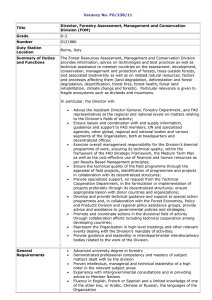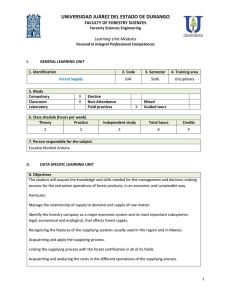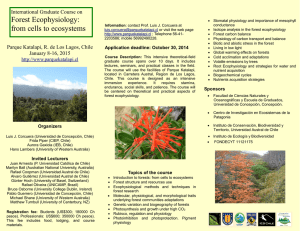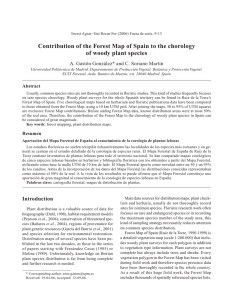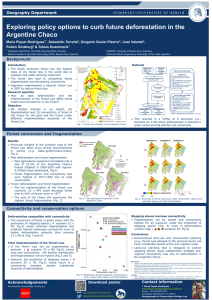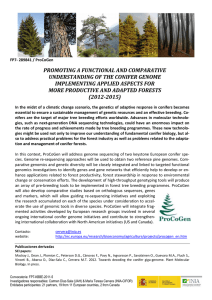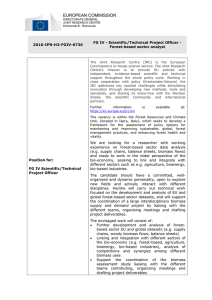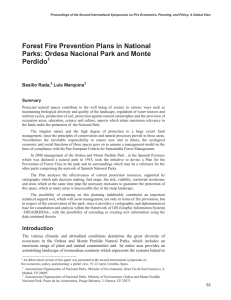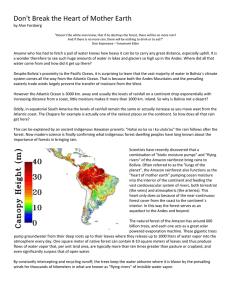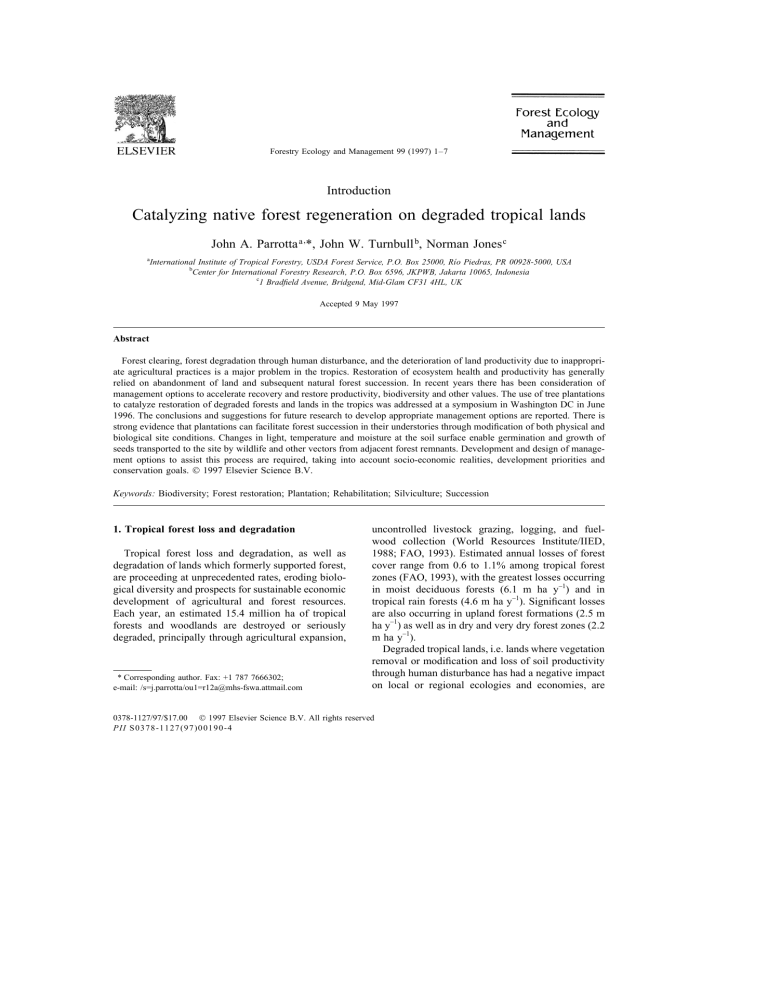
Forestry Ecology and Management 99 (1997) 1–7 Introduction Catalyzing native forest regeneration on degraded tropical lands John A. Parrotta a ,*, John W. Turnbull b, Norman Jones c a International Institute of Tropical Forestry, USDA Forest Service, P.O. Box 25000, Rı́o Piedras, PR 00928-5000, USA b Center for International Forestry Research, P.O. Box 6596, JKPWB, Jakarta 10065, Indonesia c 1 Bradfield Avenue, Bridgend, Mid-Glam CF31 4HL, UK Accepted 9 May 1997 Abstract Forest clearing, forest degradation through human disturbance, and the deterioration of land productivity due to inappropriate agricultural practices is a major problem in the tropics. Restoration of ecosystem health and productivity has generally relied on abandonment of land and subsequent natural forest succession. In recent years there has been consideration of management options to accelerate recovery and restore productivity, biodiversity and other values. The use of tree plantations to catalyze restoration of degraded forests and lands in the tropics was addressed at a symposium in Washington DC in June 1996. The conclusions and suggestions for future research to develop appropriate management options are reported. There is strong evidence that plantations can facilitate forest succession in their understories through modification of both physical and biological site conditions. Changes in light, temperature and moisture at the soil surface enable germination and growth of seeds transported to the site by wildlife and other vectors from adjacent forest remnants. Development and design of management options to assist this process are required, taking into account socio-economic realities, development priorities and conservation goals. 1997 Elsevier Science B.V. Keywords: Biodiversity; Forest restoration; Plantation; Rehabilitation; Silviculture; Succession 1. Tropical forest loss and degradation Tropical forest loss and degradation, as well as degradation of lands which formerly supported forest, are proceeding at unprecedented rates, eroding biological diversity and prospects for sustainable economic development of agricultural and forest resources. Each year, an estimated 15.4 million ha of tropical forests and woodlands are destroyed or seriously degraded, principally through agricultural expansion, * Corresponding author. Fax: +1 787 7666302; e-mail: /s=j.parrotta/[email protected] uncontrolled livestock grazing, logging, and fuelwood collection (World Resources Institute/IIED, 1988; FAO, 1993). Estimated annual losses of forest cover range from 0.6 to 1.1% among tropical forest zones (FAO, 1993), with the greatest losses occurring in moist deciduous forests (6.1 m ha y−1) and in tropical rain forests (4.6 m ha y−1). Significant losses are also occurring in upland forest formations (2.5 m ha y−1) as well as in dry and very dry forest zones (2.2 m ha y−1). Degraded tropical lands, i.e. lands where vegetation removal or modification and loss of soil productivity through human disturbance has had a negative impact on local or regional ecologies and economies, are 0378-1127/97/$17.00 1997 Elsevier Science B.V. All rights reserved PII S0378-1127 (97 )0 0190-4 2 J.A. Parrotta et al. / Forestry Ecology and Management 99 (1997) 1–7 estimated at 2077 million ha (Grainger, 1988). Of this total, an estimated 79% (1651 m ha) are desertified drylands, and the remainder are logged forest (6.6%), forest fallow (9.8%) and deforested watersheds (4.2%). This represents approximately 43% of the total land area and is slightly greater than the total estimated forest area in the tropics (FAO, 1993). 2. Responses to the problem Historically the most common response to land degradation has been abandonment, or reliance on natural succession to restore lost soil fertility, species richness, and biomass productivity. Periodic land abandonment has been the basis of apparently sustainable traditional shifting cultivation and livestock herding systems. In many tropical regions, however, fallow periods are often shortened or eliminated due to increased population pressures and agricultural intensification. Without adequate inputs such as plant nutrients, productivity and land utility commonly decline, often precipitously as in the case of pasture development in the Amazon Basin (Uhl et al., 1988a,b; Nepstad et al., 1991). In advanced stages of degradation, persistent physical, chemical and biological barriers, or stresses, often prevent natural forest successional processes from operating on a time scale compatible with human needs (Uhl and Jordan, 1984; Uhl, 1988; Lugo, 1988; Nepstad et al., 1991; Parrotta, 1992, 1993; Brown and Lugo, 1994). These barriers or stresses typically include some combination of the following: low seed or rootstock availability, seed and seedling predation, lack of suitable microhabitats for seed germination and seedling establishment, soil nutrient limitations, absence of obligate fungal or bacterial root symbionts, seasonal drought, root competition with grasses or ferns, and periodic fire (Uhl and Jordan, 1984; Uhl, 1987, 1988; Uhl et al., 1988a; Lugo, 1988; Nepstad et al., 1991; Parrotta, 1992, 1993; Cohen et al., 1995; Aide et al., 1995). Techniques for rehabilitating selected degraded areas will ultimately depend on the priorities and objectives of stakeholders, the costs and benefits associated with available rehabilitation techniques, and the economic, social, and environmental values of these land resources in their current and desired future states (Lamb, 1994). A large proportion of marginal lands currently classified as degraded can and should be rehabilitated primarily for food production. New cropping practices (such as agroforestry technologies) and more efficient agricultural resource management systems can assist this process and ensure that agriculture remains sustainable. There remain, however, significant formerly forested areas in many countries that cannot be economically rehabilitated for either agricultural or intensive commercial forestry production in the near term, and degraded lands of high potential value for conservation and watershed protection. Such sites may include degraded rangelands and pastures, riparian areas, steep slopes subject to severe erosion, or sites which could serve as corridors linking forest fragments of high biodiversity value. An unknown proportion of these lands will naturally revert fairly quickly to secondary forest if the pressures on them (i.e., biomass harvesting, grazing, fire) are lifted, as occurred in parts of Latin America and elsewhere where substantial areas of secondary forest have established following the collapse of cattle raising activities (Brown and Lugo, 1990; Sips, 1993). Other, more severely degraded lands, will require some form of human intervention, or management, to facilitate their recovery. To date, tropical forest rehabilitation efforts have tended to focus on the development of forestry and agroforestry systems aimed at maximizing production of a very limited number of species, or restoration plantings (usually at considerable cost) that aim to recreate the diverse forest ecosystem believed to have once occupied the site. Intensive forestry and agroforestry systems have limited potential for biodiversity conservation. Although ecosystem restoration approaches can yield extremely good results in terms of biodiversity recovery, their high costs make them economically unattractive for large-scale application in tropical countries except under very specialized circumstances. What is needed for large-scale application in many regions are forest rehabilitation and management systems that simultaneously accelerate regeneration of species-rich native forest ecosystems and provide economically and socially valued forest products (cf. Poffenberger and McGean, 1996). J.A. Parrotta et al. / Forestry Ecology and Management 99 (1997) 1–7 3. The potential role of plantations There is increasing evidence that forest plantations can play a key role in harmonizing long-term forest ecosystem rehabilitation or restoration goals with near-term socio-economic development objectives (cf. Lamb and Tomlinson, 1994). Recent studies have shown that plantations can facilitate, or ‘catalyze’, forest succession in their understories, particularly where silvicultural management was neglected, on sites where persistent ecological barriers to succession would otherwise prelude recolonization by native forest species. See, for example, Lugo (1992), Parrotta (1992, 1993, 1995), and Lugo et al. (1993) for Puerto Rico; Guariguata et al. (1995) for Costa Rica; Vieira et al. (1994) and Silva Junior et al. (1995) for Brazil; Knight et al. (1987), Lübbe and Geldenhuys (1991), Geldenhuys (1993, 1996), and van Wyk et al. (1995) for South Africa; Fimbel and Fimbel (1996) for Uganda; Yu et al. (1994) for China; Bhaskar and Dasappa (1986), Kushalappa (1986), Soni et al. (1989), George et al. (1993) and Srivastava (1994) for India; Mitra and Sheldon (1993) for Malaysia; and Kuusipalo et al. (1995) for Indonesia. These studies suggest that, under certain circumstances, the catalytic effect of plantations is due to changes in understory microclimatic conditions, increased vegetation structural complexity, and development of litter and humus layers that occur during the early years of plantation growth. These changes lead to increased seed inputs from neighboring native forests by seed dispersing wildlife attracted to the plantations, suppression of grasses or other lightdemanding species that normally prevent tree seed germination or seedling survival, and improved light, temperature and moisture conditions for seedling growth. In the absence of silvicultural management aimed at eliminating woody understory regeneration, the monospecific plantation system is replaced by a mixed forest comprised of the planted species and an increasing number of early and late successional tree species and other floristic elements drawn from surrounding forest areas. Eventually, if the planted species are short-lived and light-demanding (as are most of the commonly planted commercial species), they may disappear entirely from the system, leaving a floristically rich secondary forest. Alternatively, if the planted trees are gradually removed with- 3 out also removing the woody understory regeneration, a secondary forest could develop quickly. 4. Plantations as successional catalysts: an international research effort Based on these earlier findings, a global research network was initiated in 1994 by the World Bank and the International Institute of Tropical Forestry (USDA Forest Service) in collaboration with the Center for International Forestry Research (CIFOR) and the Overseas Development Authority/UK (ODA) to critically evaluate the role of forest plantings in rehabilitating native forest biodiversity on severely degraded or deforested lands. This research effort involved field research in Puerto Rico, Costa Rica, Brazil, Congo, South Africa, Malawi, Australia, and Hawaii and extensive networking with scientists from over 20 countries involved in closely related studies, principally through the International Union of Forestry Research Organizations (IUFRO) Project Group P1.17.00 (Rehabilitation of Degraded Sites). The first phase of this research program, completed in 1996, focused on better understanding the ‘catalytic effect’ of tree plantings on native forest succession under a variety of degraded site conditions. Using a common research methodology, study teams examined a series of hypotheses concerning the relative importance of environmental conditions, plantation species selection and other design criteria, and silvicultural management practices on the process of native forest regeneration in established plantations. Papers reporting results of this project are presented in this volume by Bone et al., Geldenhuys, Haggar et al., Harrington and Ewel, Keenan et al., Loumeto and Huttel, Parrotta et al., Powers et al., and Tucker and Murphy. 5. The IUFRO-World Bank-USDA forest service conference on tropical forest rehabilitation In June 1996, a 4-day symposium/workshop was held in Washington DC to discuss the results of these and related studies, and to chart a course for future research. The meeting included scientists involved in the international research project 4 J.A. Parrotta et al. / Forestry Ecology and Management 99 (1997) 1–7 described above, other researchers and land managers from numerous countries involved in tropical land rehabilitation, forest restoration, and secondary forest management, and representatives from multilateral donor agencies, environmental NGOs and the private sector interested in multiple-use management of commercial plantations and natural forest systems. The symposium included 28 invited papers, presented in eight technical sessions on forest plantation ecology, tropical forest succession, forest rehabilitation and restoration of degraded tropical sites, silvicultural options for secondary forest management, and social, economic, and policy issues. Two workshops provided an opportunity for conference participants to evaluate the hypotheses that guided the international research project on plantations as successional catalysts, to identify areas for further research, and to discuss the potential applications of project results under a variety of management conditions. Workshop participants considered the following questions: • • • • • Do plantations accelerate natural forest succession on degraded tropical sites? If so, what site conditions, plantation designs (species selection, spacing, etc.), and silvicultural management practices (site preparation, understory management, thinning regimes) favor the adoption of this technique for native forest rehabilitation/restoration over alternative methods? What is the role of wildlife in the process and how can plantations be designed to increase their effectiveness as seed-dispersers? To what extent does the regeneration of a diverse understory flora affect the productivity of the planted crop in plantations established primarily for timber production, and how can the regeneration process be managed to optimize yields of a diverse product mix to meet economic, social, and environmental conservation objectives? What are the potential uses of the ‘catalytic effect’ of plantations to harmonize forest production goals and forest rehabilitation and/or restoration objectives? The following conclusions and suggestions for future research emerged from the workshop: 1. Relative to unplanted (control) sites, plantations have a marked catalytic effect on native forest development (succession) on severely degraded sites (such as mined lands and badly eroded areas) and on sites dominated by grasses and ferns which otherwise preclude colonization by forest species. 2. The relative catalytic effect of plantations increases with increased site degradation and from drier to wetter sites, and generally decreases with increasing distance from remnant native forest stands (seed sources). Further research is recommended to develop techniques for accelerating natural forest succession on drier sites. 3. Structural complexity of the planted forest is an important determinant of subsequent biodiversity enrichment due to the importance of habitat heterogeneity for seed-dispersing wildlife and microclimatic heterogeneity for seed germination. This suggests that broadleaf species yield generally better results than conifers, and that mixed-species plantings are preferable to monocultures. Future studies in this area are needed to assess the influence of overstory (planted) species architecture and phenology on understory microclimate heterogeneity (spatial and temporal patterns), and aspects of forest floor and soil development that influence recruitment of native forest species, under a variety of site and landscape conditions. 4. Wildlife, especially bats and birds, are of fundamental importance as seed dispersers in tropical regions. Their effectiveness in facilitating plantation-catalyzed biodiversity development on degraded sites depends on the distances they must travel between seed sources (remnant forests) and plantations, the attractiveness of the plantations to wildlife (ability of plantations to provide habitat and food), and the condition of the forests from which they are transporting seeds. Additional research is needed under a variety of ecological conditions to better understand the dynamics of animal seed dispersal in degraded landscapes, to develop appropriate plantation designs to encourage seed transport from remnant forest stands, and to determine the range of distances between seed sources and rehabilitation sites over which seed dispersal by animals is likely to be effective. J.A. Parrotta et al. / Forestry Ecology and Management 99 (1997) 1–7 5. Larger-seeded forest species are far less likely to colonize degraded sites than smaller-seeded species due to seed dispersal limitations, and therefore require management interventions (e.g., enrichment planting) to facilitate their establishment, particularly where forest restoration is a major objective. Further studies are recommended to develop low-cost techniques for establishing large-seeded species either at the time of plantation establishment, or as enrichment plantings at appropriate stand ages. 6. Regarding silvicultural management options, the workshop examined the effects of site preparation alternatives (mechanical, fire, chemical), understory management practices, and plantation thinning regimes on both the planted trees and the species-rich native forest understory they foster. Due to the complexity of interactions among the many factors involved, however, specific recommendations are dependent on initial site conditions, the goals of plantation management, and the relative importance of the planted trees for timber or biomass, the regenerating understory, and other socio-economic and environmental goods and services provided by the rehabilitating forest system. The issue of ‘trade-offs’ between overstory productivity and understory development was identified as an important topic for further study, requiring experimental studies to determine the effect of plantation understory regeneration on overstory growth and nutrient cycling processes during the course of stand development. 7. There was a broad consensus that the ‘catalytic plantation’ approach is a promising tool for degraded land rehabilitation in a variety of contexts. Given the growing recognition in the scientific and development communities, among policy-makers, and in the private sector of the need to incorporate biodiversity rehabilitation and conservation in land-use planning and forest management, this approach is attracting broad interest as an economically and socially viable means for integrating social, economic and environmental land management goals. The potential applications discussed included ‘restoration’ plantations in riparian areas and on other critical sites (such as steep eroded slopes); plantings designed 5 to foster development of mixed native forests for a variety of locally used and valued species; and alternative management strategies for long-rotation timber plantations, short-rotation fuelwood or fiber plantations, and agroforestry systems. Management issues and potential applications discussed during the workshops clearly indicate the need for additional research in a number of areas related to plantation design and management. Specifically, experimental research is required to systematically evaluate the effects of site preparation, plantation species selection (both single- and mixed-species alternatives), understory management practices, and stand manipulation techniques (e.g., pre-commercial thinnings, liberation thinnings, enrichment plantings) on the productivity of both the planted crop and its regenerating understory, the associated economic and social costs and benefits, and the environmental impacts of alternative design and management systems related to biodiversity conservation, soil fertility rehabilitation and carbon sequestration. These questions need to be addressed in the context of local ecological conditions. There must also be recognition of the current and future priorities of local communities, individual landholders and land managers to ensure that forest rehabilitation and management options evaluated are consistent with socio-economic realities, development priorities and conservation goals. 6. Applying the catalytic plantation approach to forest rehabilitation and restoration Given the information currently available, careful selection of sites and cost/benefit analysis will be needed should any government, commercial company or NGO wish to give rehabilitation through catalytic tree planting a trial. Degraded sites to be favored should be those formerly cleared of all, or at least most, tree and shrub roots, e.g., land cleared for pasture or commercial crops such as sugar cane or bananas. Potential users of this technique must determine distances from the nearest natural forest remnants and give priority to sites with distances advantageously disposed to seed vectors. Once sites are chosen, careful selection of planted 6 J.A. Parrotta et al. / Forestry Ecology and Management 99 (1997) 1–7 species is required. While most species appear to act as catalysts, broadleaf species seem to give better results than conifers. Of these, fast growing pioneer species should have preference, particularly those known to establish and grow well on degraded sites, e.g., Acacia mangium on imperata grassland sites in the tropics. In many regions, however, there is a real danger that some plantation species (notably certain Acacia species and Leucaena leucocephala) could ‘escape’ from cultivation and become established as weedy invader plants well beyond the rehabilitation target area. Therefore, candidate plantation species should be screened for their potential to become problematic weeds in relation to local and regional floristics and ‘invasibility’ of surrounding ecosystems. Where possible, native species should be given preference over exotics, in part to help minimize this risk. Seedlings should be of good quality and spacing chosen to favor early canopy closure. Plantation establishment costs need to be kept as low as possible consistent with good survival and growth. Similarly, post-plantation treatments should be minimized, provided canopy development of the planted trees is proceeding well. Subsequent silvicultural treatments should be chosen to capitalize on the colonizing species; no hard and fast rules are possible given the present state of knowledge. Timing of silvicultural operations may prove critical as early colonization by forest species has been observed in the understory of Gmelina arborea in Costa Rica (N. Jones, personal observation), and beneath Albizia lebbek, Casuarina equisetifolia, Eucalyptus robusta, and Leucaena leucocephala in Puerto Rico (Parrotta, 1992, 1993, 1995) as early as the third year after planting. Local benefits from applying catalytic planting on sites where natural forest successional processes are arrested can be both financial (employment for planting and management) and ecological (colonization of native forest species and development of a forest environment). 7. Conclusions There is strong evidence that plantations can facilitate forest succession in their understories on degraded sites through modifying microclimatic conditions, stimulating accumulation of organic carbon in the soil surface layers and increasing structural complexity. Changes in light, temperature and moisture at the soil surface provides conditions to enable germination and growth of seeds transported to the site by wind, wildlife and other vectors from adjacent forest remnants. Strategic and applied research is required to develop and design management options to facilitate natural regeneration in plantations. These options will need to be developed in full recognition of socio-economic realities, development priorities and conservation goals. Acknowledgements This work was conducted in cooperation with the University of Puerto Rico and supported in part by a grant from the World Bank to the International Institute of Tropical Forestry, USDA Forest Service (Research Support Budget Grant RPO #680-05: ‘The catalytic effect of tree plantings on the rehabilitation of native forest biodiversity on degraded tropical lands’). The authors thank David Lamb and Coert J. Geldenhuys for their helpful comments on an earlier version of this paper. References Aide, M.T., Zimmerman, J.K., Herrara, L. and Rosario, M., 1995. Forest recovery in abandoned tropical pastures in Puerto Rico. For. Ecol. Manage., 77: 77–86. Bhaskar, V. and Dasappa, 1986. Ground flora in Eucalyptus plantations of different ages. In: J.K. Sharma, C.T.S. Nair, S. Kedharmath and S. Kondas (Editors), Eucalypts in India: Past, Present and Future. Kerala Forest Research Institute, Peechi, Kerala, pp. 213–224. Brown, S. and Lugo, A.E., 1990. Tropical secondary forests. J. Trop. Ecol., 6: 1–32. Brown, S. and Lugo, A.E., 1994. Rehabilitation of tropical lands: a key to sustaining development. Rest. Ecol., 2: 97–111. Cohen, A.L., Singhakumara, B.M.P. and Ashton, P.M.S., 1995. Releasing rainforest succession: a case study in the Dicranopteris linearis fernlands of Sri Lanka. Rest. Ecol., 3: 261–270. FAO, 1993. Forest resources assessment 1990. Tropical countries. FAO Forestry Paper 112. United Nations Food and Agriculture Organization, Rome. 61 pp. + appendices and tables. Fimbel, R.A. and Fimbel, C.C., 1996. The role of exotic conifer plantations in rehabilitating degraded tropical forest lands: a case study from the Kibale Forest in Uganda. For. Ecol. Manage., 81: 215–226. J.A. Parrotta et al. / Forestry Ecology and Management 99 (1997) 1–7 Geldenhuys, C.J., 1993. Management of forestry plantations to become effective stepping stones and corridors for forest migration. In: D.A. Everard (Editor), The Relevance of Island Biogeography Theory in Commercial Forestry, Environmental Forum Report, FRD, Pretoria. pp. 102–118. Geldenhuys, C.J., 1996. The Blackwood Group System: its relevance for sustainable forest management in the southern Cape. S. Afr. For. J., 177: 1–21. George, S.J., Kumar, B.M. and Rajiv, G.R., 1993. Nature of secondary succession in the abandoned Eucalyptus plantations of Neyyar (Kerala) in peninsular India. J. Trop. For. Sci., 5: 372– 386. Grainger, A., 1988. Estimating areas of degraded tropical lands requiring replenishment of forest cover. Int. Tree Crops J., 5: 31–61. Guariguata, M.R., Rheingans, R. and Montagnini, F., 1995. Early woody invasion under tree plantations in Costa Rica: implications for forest restoration. Rest. Ecol., 3: 252–260. Knight, R.S., Geldenhuys, C.J., Masson, P.H., Jarman, M.L. and Cameron, M.J. (Editors), 1987. The Role of Aliens in Forest Edge Dynamics: A Workshop Report. Occasional Report No. 22, Ecosystems Programmes, FRD, CSIR, Pretoria. 41 pp. Kushalappa, K.A., 1986. Nutrient status in Eucalyptus hybrid monoculture. In: J.K. Sharma, C.T.S. Nair, S. Kedharnath and S. Kondas (Editors), Eucalypts in India: Past, Present and Future. Kerala Forest Research Institute, Peechi, Kerala, India. pp. 213– 224. Kuusipalo, J., Ådjers, G., Jafarsidik, Y., Antii, O., Tuomela, K. and Vuokko, R., 1995. Restoration of natural vegetation in degraded Imperata cylindrica grassland: understory development in forest plantations. J. Veg. Sci., 6: 205–210. Lamb, D., 1994. Reforestation of degraded tropical forest lands in the Asia-Pacific region. J. Trop. For. Sci., 7: 1–7. Lamb, D. and Tomlinson, M., 1994. Forest rehabilitation in the Asia-Pacific region: past lessons and present uncertainties. J. Trop. For. Sci., 7: 157–170. Lübbe, W.A. and Geldenhuys, C.J., 1991. Regeneration patterns in planted and natural forest stands near Knysa, Southern Cape. S. Afr. J. For., 159: 43–50. Lugo, A.E., 1988. The future of the forest—ecosystem rehabilitation in the tropics. Environment, 30: 16–20, 41–45. Lugo, A.E., 1992. Tree plantations for rehabilitating damaged lands in the tropics. In: M.K. Wali (Editor), Environmental Rehabilitation, vol. 2. SPB Academic Publishing, The Hague, pp. 247–255. Lugo, A.E., Parrotta, J.A. and Brown, S., 1993. Loss of species caused by tropical deforestation and their recovery through management. Ambio, 22: 106–109. Mitra, S.S. and Sheldon, F.H., 1993. Use of exotic tree plantations by Bornean lowland forest birds. Auk, 110: 529–540. Nepstad, D., Uhl, C. and Serrão, E.A., 1991. Recuperation of a degraded Amazonian landscape: forest recovery and agricultural restoration. Ambio, 20: 248–255. 7 Parrotta, J.A., 1992. The role of plantation forests in rehabilitating degraded ecosystems. Agric. Ecosys. Environ., 41: 115–133. Parrotta, J.A., 1993. Secondary forest regeneration on degraded tropical lands: the role of plantations as ‘foster ecosystems’. In: H. Lieth and M. Lohmann (Editors), Restoration of Tropical Forest Ecosystems. Kluwer, Dordrecht, pp. 63–73. Parrotta, J.A., 1995. The influence of overstory composition on understory colonization by native species in plantations on a degraded tropical site. J. Veg. Sci., 6: 627–636. Poffenberger, M. and McGean, B. (Editors), 1996. Village Voices, Village Choices: Joint Forest Management in India. Oxford University Press, New Delhi, 356 pp. Silva Junior, M.C., Scarano, F.R. and Souza Cardel, F., 1995. Regeneration of an Atlantic forest formation in the understory of a Eucalyptus grandis plantation in southeastern Brazil. J. Trop. Ecol., 11: 147–152. Sips, P., 1993. Management of Tropical Secondary Rain Forests in Latin America. Today’s Challenge, Tomorrow’s Accomplished Fact? Working Document IKC-NBLF No. 27. Foundation Bos, Wageningen, The Netherlands, 71 pp. Soni, P., Vasistha, H.B. and Kumar, O., 1989. Biological diversity in surface mined areas after reclamation. Ind. For., 115: 475– 482. Srivastava, R.K., 1994. Re-establishment of sholas in grassland (a reverse process). Ind. For., 120: 868–870. Uhl, C., 1987. Factors controlling succession following slash-andburn agriculture in Amazonia. J. Ecol., 75: 377–407. Uhl, C., 1988. Restoration of degraded lands in the Amazon basin. In: E.O. Wilson (Editor), Biodiversity. National Academy Press, Washington, pp. 326–332. Uhl, C. and Jordan, C., 1984. Succession and nutrient dynamics following forest cutting and burning in Amazonia. Ecology, 65: 1476–1490. Uhl, C., Buschbacher, R. and Serrão, E.A.S., 1988a. Abandoned pastures in eastern Amazonia. I. Patterns of plant succession. J. Ecol., 76: 663–681. Uhl, C., Buschbacher, R. and Serrão, E.A.S., 1988b. Abandoned pastures in eastern Amazonia. II. Nutrient stocks in the soil and vegetation. J. Ecol., 76: 682–699. van Wyk, G.F., Everard, D.A. and Geldenhuys, C.J., 1995. Forest Ecotone Development and Succession: Experimental Results and Guidelines for Forest Rehabilitation and Protection. Report FOR-DEA 867. CSIR, Pretoria, 34 pp. Vieira, I.C.G., Uhl, C. and Nepstad, D., 1994. The role of the shrub Cordia multispicata Cham. as a ‘succession facilitator’ in an abandoned pasture, Paragominas, Amazônia. Vegetatio, 115: 91–99. World Resources Institute/IIED, 1988. World Resources 1988–89. Basic Books, New York, 372 pp. Yu, Z.Y., Wang, Z.H. and He, S.Y., 1994. Rehabilitation of eroded tropical coastal lands in Guangdong, China. J. Trop. For. Sci., 7: 28–38.
